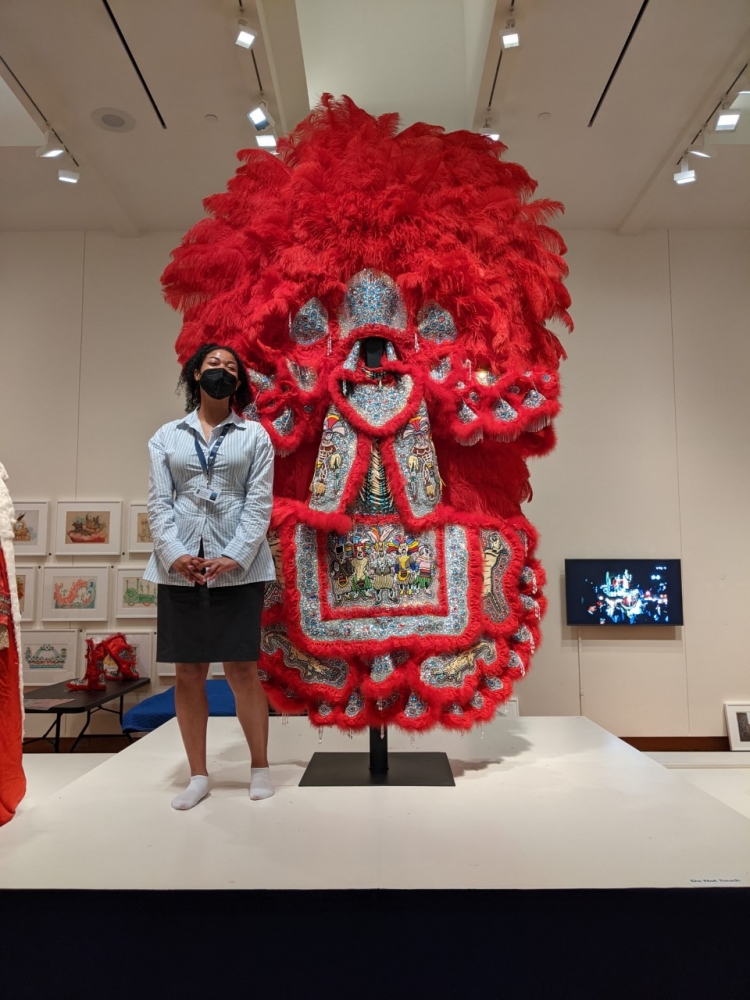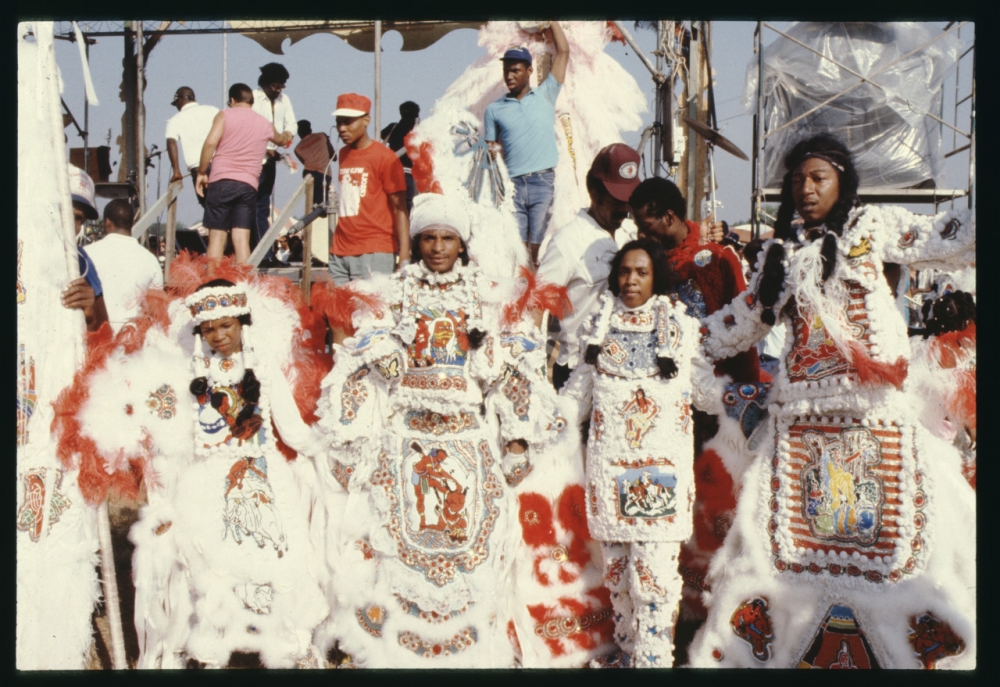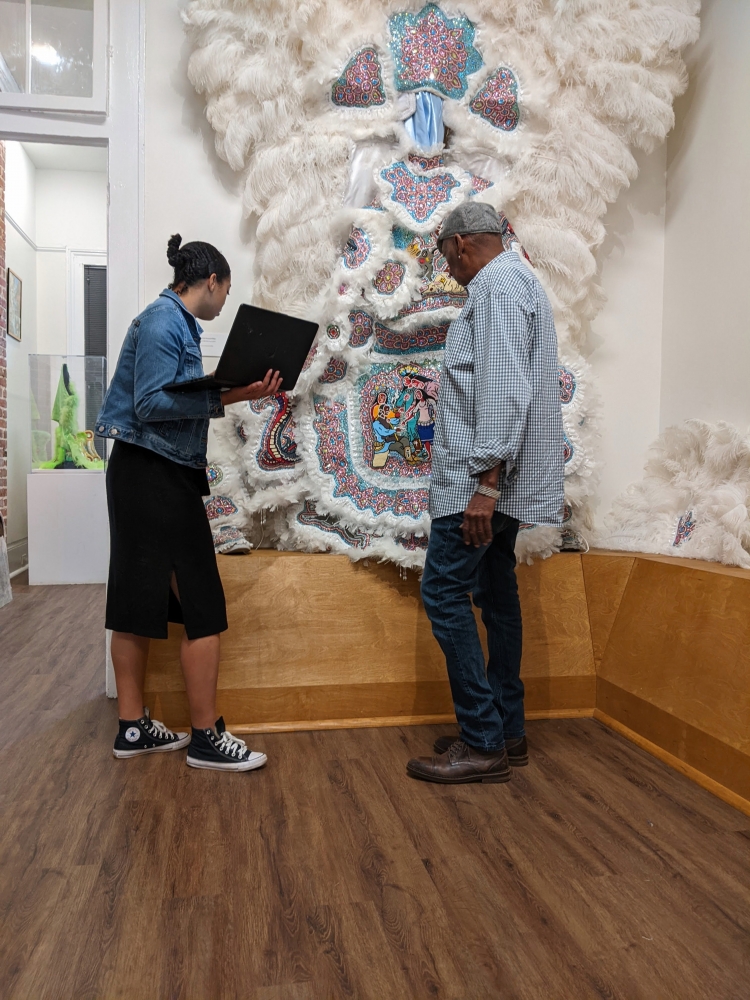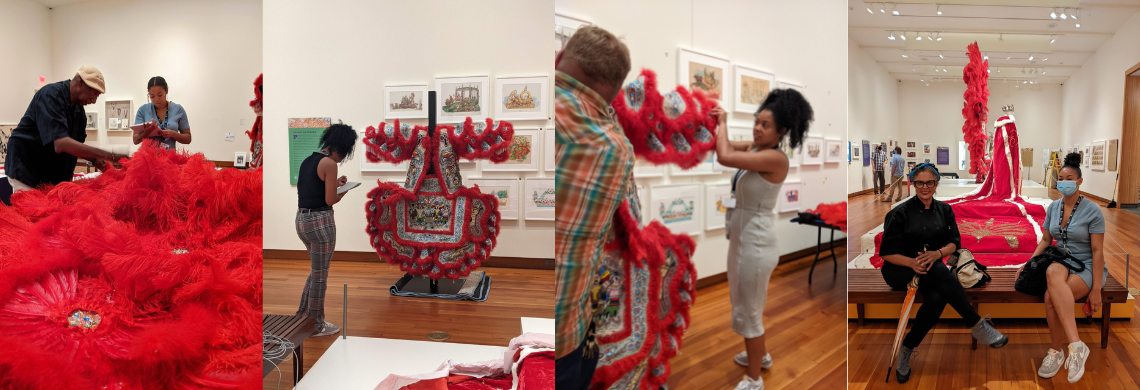THNOC’s acquisition of a suit made in 2017–18 by Chief Howard Miller of the Creole Wild West posed a unique challenge. Each year, Miller and other Black Masking Indians (also called Mardi Gras Indians) embark on a spiritual journey to complete a new suit for Carnival season. This rigorous process takes all year, designing, constructing, and hand-sewing thousands of beads and rhinestones that will eventually come together to paint a picture telling an elaborate story. The process is also expensive—supplies to make a suit can easily run into the thousands. Still, most won’t last past the Carnival season they were made for. Since it is customary to make a new suit each year, the previous year’s suit becomes an impractical keepsake.

Loren C. Brown, THNOC’s summer 2022 decorative arts intern, stands with Chief Howard Miller’s suit when it was on display in the exhibition Making Mardi Gras. (Photograph by THNOC Decorative Arts Curator Lydia Blackmore)
Storing past suits is no easy task. These pieces can weigh upwards of 180 pounds and stand as much as 10 feet tall. They tend to not fit or stay in mint condition in a humid New Orleans house or apartment. For most Black Masking Indians, it’s more practical to break the previous year’s suit down, keeping patches and rhinestones to be repurposed for upcoming years.
Cultural institutions have also struggled with storing Black Masking Indians’ suits. While there is a movement to preserve the tradition’s history in the form of books and documentaries, little research on material preservation has been done on an institutional level. It is difficult to find clear guidelines or public talks about how to properly care for these objects once they are in the hands of collectors or institutions. Thus, when THNOC acquired Chief Miller’s suit, it created the opportunity for my internship, generously funded by a grant from the Decorative Arts Trust. I spent four months working under the guidance of Chief Miller and THNOC’s Curator of Decorative Arts Lydia Blackmore to come up with solutions and proper care protocols that could be useful to other institutions, collectors, and the Black Masking community.
Some of the challenges institutions face when storing and preserving Black Masking Indian suits are material. One of the most striking aspects of the suits is their imposing size; Miller’s 2018 suit is 10 feet tall and 5 feet wide. What is the best way to store and display these massive works of art without damaging them? Should a suit be displayed on a mannequin, or should each piece have its own personal stand to support the weight? Is it acceptable to store suits upright, or should they be laid flat with each piece in its own box? How do we find space to store such an enormous object? How can we combat and prevent larger feathers from drooping and beads from falling?
In addition to the material difficulties associated with preserving Black Masking Indian suits, there are ethical questions surrounding conservation and what is appropriate to be done and by whom. These suits are not just pretty costumes; as many pracititioners have stated, they also hold a deeper spiritual significance, and so we must consider a respectful way to care for them. For instance, when repairs are necessary, it may be best to have the original maker or a member of the maker’s tribe perform the work instead of a textile conservator. In order to avoid adding new elements to the suit, it may be preferable to employ the same materials used to originally make the suit—however unconvential, such as hot glue—rather than current conservation adhesives.

Members of the Creole Wild West, including Chief Howard Miller (on the far right) in their suits in the early 1980s. (THNOC, 2007.0103.8.1595)
Perhaps most importantly, there is this question: How can we respect the spirituality attached to the suits and create a less extractive relationship between the institution and the Black Masking community?
I have spent time pondering these questions to develop a public preservation guide that covers everything from spiritual integrity to physical materials. Hopefully, my findings will provide ideas and solutions to the unique challenges that institutions, collectors, and artists face when dealing with the preservation of Black Masking Indian suits.

Loren C. Brown consults with Chief Howard Miller to assess a suit. (Photograph by THNOC Decorative Arts Curator Lydia Blackmore)
I am grateful to The Historic New Orleans Collection and The Decorative Arts Trust for recognizing the need to better understand the preservation of Black Masking Indian suits and for providing me with this opportunity. I am especially grateful to the Black Masking community and Chief Miller for guiding me, sharing their perspectives, and allowing me to learn more about this cultural tradition. This was a truly unparalleled opportunity to collaborate with not only museum professionals, but also an entire community.












